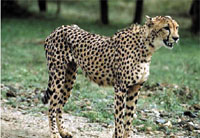
Save biodiversity in Yemen [Archives:2005/878/Health]
September 19 2005
 |
 |
 |
YEMEN TIMES STAFF
Modern populations and the pressures of urbanization have reduced both the abundance and habitat available to the myriad species with whom we share the planet. Many species face extinction (50-200 species are lost to this planet every day – 20,000 to 70,000 per year). The implications of our myopic and ecologically ruinous patterns of behavior are not easily understood and their effects may not yet have been realized.
Biodiversity, is a term that is now commonly used to describe the variety of living things and their relationships to each other and interactions with the environment. According to that, we cannot expect to find deer or ducks in the wild in the absence of the interconnected web of other plants and animals on which their lives depend.
The notion of biodiversity encompasses several different levels of biological organization, from the very specific to the most general. Perhaps the most basic is the variety of information contained in the genes of specific organisms, be they petunias or people. Different combinations of genes within organisms, or the existence of different variants of the same basic gene are the fundamental \”stuff\”” of evolution. At the next level is the variety of different species that exist on the Earth: a concept that includes the relationship of different groups of species to each other. Biodiversity also describes the varied composition of ecosystems


